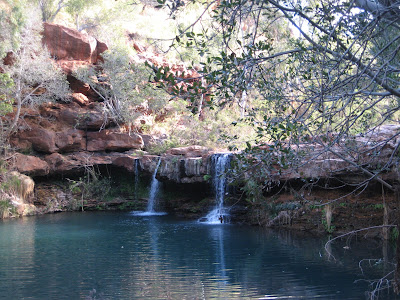


From Tom Price - highest town in W.A., (where we had about 1mm of rain overnight), we called into Hammersley Gorge on the edge of Kurijini N.P.- the most interesting rock formations and colours we have seen, a waterfall over very large rocks into a beautiful, quiet, still poool of green clear water and tinyfish.
Another 40km or so on sometimes very rough and dusty roads brought us to Mt Florence Station for lunch. The grassy site was very welcome and we sat under a tree reading books and watching birds. The station workers returned late in the day from mustering 600 cattle into a yard 30 km from the homestead. They came by battered utes, motorbikes and a helicopter. The camp park is surrounded by spinifex plains, but some big trees in the camp ground.
Despite all of our covering of vents there was still a lot of dust in the van when we arrived at Millstream-Chinchester N.P. next day. This park is a real oasis in a semi arid environment. The Fortescue river has a wide bed which is fed by the Millstream which is filled from springs from an underground aquifer. The Parks Visitor Centre is the old homestead and much of the old garden of palms is still to be seen. The Millstream pool is beautiful with plants growing under the water, lily plants on the top and small fish easily seen in the clearest water we have ever seen.

After a second lovely and lazy day in Millstream (including a 6km walk) we travelled over some terribly rough road toward Karratha, finally reaching bitumen with 100km to go. We travelled through some interesting country - small hills with exposed dark brown rocks tumbling down the side, looking like humans have dumped truck loads of unwanted rocks. Everywhere there was evidence of the mining industry. Railway lines (we saw 3 trains), new lines being built - work camps everywhere, powerlines criss- crossing over the hills, road trains, and of course the 4WD,s complete with flags and security codes on the side - we think we will put a sticker on our car - MBGNSAVAN - that will make them think!
Two days in the Karratha / Dampier area saw us doing domestic things including trying to clean the inside of the van and washing the car. We also enjoyed learning about the area. As well as a major port for Rio Tinto - it's where all the trains come, it is also the base of the North West Shelf Gas Project. The extent of this project amazed us and the excellent visitor centre gave us plenty of information to absorb. An off shoot industry uses the natural gas to produce hydrogen and then liquid ammonia via the Haber process - for all those chemists out there. Dampier and all of the industry is on the Burrup Peninsula where very significant ancient rock art exists in sight of towers flaring gas. Karratha is the well planned dormitory town for the workers and is quite a pleasant place, nice parks, good schools and public buildings and a large shopping centre.
It was interesting to read in the local paper that the Dampier community, closely followed by the Karratha community, is the richest community in Australia. Over one quarter of the families have a weekly income over $4,000. Mind you house rentals are around $2,000 per week. It must be hard for a single shop assistant to live in these towns. Also, it seems as though the number of fly in fly out (FIFOS) workers is increasing as this is most economical system for the larger industries.
It was also interesting to learn that one of the Rio Tinto iron ore mines is now using driverless trucks. I don't know how it works but I hope they don't have too many computer gliches - those trucks cost about 6 million dollars each.
You can see we are learning heaps! Over the next 3 days we will be exploring the historic Point Samson, Roebourne and Cossack regions.































































